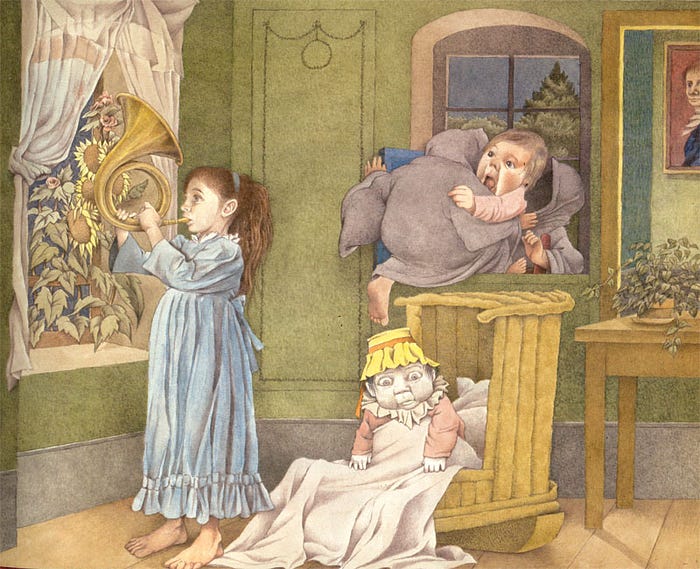Understanding Maurice Sendak
Jonathan Cott writes about “Outside Over There” (from the Washington Post)

When Maurice Sendak died in 2012, obituaries looked back at dozens of terrific children’s books written over his lifetime, as well as memorable set designs for ballets and operas. But his watershed moment had probably been some 30 years earlier. In 1981, he published Outside Over There, the last in his picture-book trilogy that began with Where the Wild Things Are and In the Night Kitchen.
Jonathan Cott came to know Sendak during this golden time, interviewing him in 1976 for Rolling Stone and later featuring Sendak in an extended profile in his 1983 book Pipers at the Gates of Dawn: The Wisdom of Children’s Literature. Then life intervened, and Cott, one of our most interesting public scholars, published books on other geniuses — among them, Susan Sontag, Lafcadio Hearn, and Bob Dylan. Now Cott has returned to Sendak and produced a biography that uses Outside Over There as the key to this great artist’s life and work.
Cott has chosen his focus wisely. Tony Kushner — best known for his “Angels in America” but also the author of The Art of Maurice Sendak — has called Outside Over There Sendak’s “last completely successful great book.” And Cott himself argues that “to understand Outside Over There is in large part to understand Sendak himself,” which he intimated in his 1981 review of the book in The Washington Post.

Outside Over There is a brilliant picture book composed of masterly illustrations and a deep, gnomic story that does not easily yield to summary: Ida is a girl obliged to watch her baby sister because Papa is away at sea and Mama is distracted. When Ida turns her back and plays her Wonderhorn, goblins kidnap her sister and leave a changeling in her place. But Ida is clever and by a magic trick discovers the ruse and sets out to rescue her sister just before a goblin wedding. Then Ida returns home, embracing her rescued sister.
Remarkable pictures accompany this mysterious story. At this point in his career, Sendak could easily employ any kind of artistic style he wanted — the simple sketches for Where the Wild Things Are, the comic-book format of In the Night Kitchen or the Dürer-like crosshatching of The Juniper Tree. Here the style is German Romantic, golden and 19th century. Indeed, the pictures are of such supernal excellence that Sendak’s publisher released the title on both its children’s and adult lists.
As for what Outside Over There means, it is important to know that Sendak was involved for years in psychoanalysis and described this book as “the excavation of my soul.” As the title of Cott’s book suggests, “there’s a mystery there.”

Sendak himself only half understood his book. He noted, for example, the reappearance of his childhood obsession with the Lindbergh baby kidnapping, and he recognized the influence of the Grimm Brothers’ tale “The Goblins.” But Sendak continued to puzzle out his book in conversations with others, especially with Cott in those exchanges printed in Pipers at the Gates of Dawn. Those original “excavations” reappear in this new biography.
But There’s a Mystery There ventures into new territory, too. Cott has interviewed four experts who offer their own views on Outside Over There: Richard M. Gottlieb, a psychoanalyst; Margaret Klenck, a Jungian analyst; Jane Doonan, an art historian; and Kushner, who was Sendak’s friend. Here is literary criticism as brilliant conversation.
While occasionally the specialists ride their own hobby horses (the Jungian, for example, dragoons Sendak’s book into a tale of “individuation”), more commonly the experts’ revelations are spot on and their questions illuminating: Why is this largely a female story (when Sendak usually features boys)? How is the color used for the goblins echoed in other objects? And so on. Moreover, Cott urges on his interlocutors with his own keen insights, and he quotes from Rumi, James Baldwin and dozens of others. Even for someone such as me, who has written about and taught Outside Over There for decades, new insights poured in so fast I sometimes had to put the book down and catch my breath.
Italo Calvino has suggested that when it comes to a classic, what is important “is the possibility of being able to continue to unpeel it like a never-ending artichoke, discovering more and more new dimensions in reading.” This is the very richness available in Sendak’s Outside Over There and discovered in Cott’s There’s a Mystery There.
This essay originally appeared in the Washington Post (Sept 21, 2017). My review of Cott’s “Pipers at the Gates of Dawn” appeared in the Los Angeles Times Book Review:
Among my other writings about Sendak, you will find my review of “Outside Over There” for The Nation and my essay about gay themes in the book in an essay for “Horn Book”:
If you liked this, “clap” below so others will see this on Medium. To see the ten most popular entries on this blog, click here. And if you’d like to read more essays like this, click the “follow” button at the top of this page.
